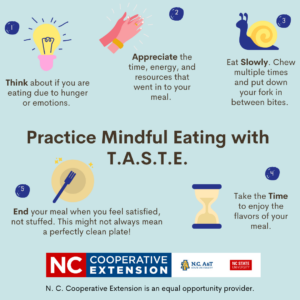What Is ‘Mindful Eating’?
go.ncsu.edu/readext?836749
en Español / em Português
El inglés es el idioma de control de esta página. En la medida en que haya algún conflicto entre la traducción al inglés y la traducción, el inglés prevalece.
Al hacer clic en el enlace de traducción se activa un servicio de traducción gratuito para convertir la página al español. Al igual que con cualquier traducción por Internet, la conversión no es sensible al contexto y puede que no traduzca el texto en su significado original. NC State Extension no garantiza la exactitud del texto traducido. Por favor, tenga en cuenta que algunas aplicaciones y/o servicios pueden no funcionar como se espera cuando se traducen.
Português
Inglês é o idioma de controle desta página. Na medida que haja algum conflito entre o texto original em Inglês e a tradução, o Inglês prevalece.
Ao clicar no link de tradução, um serviço gratuito de tradução será ativado para converter a página para o Português. Como em qualquer tradução pela internet, a conversão não é sensivel ao contexto e pode não ocorrer a tradução para o significado orginal. O serviço de Extensão da Carolina do Norte (NC State Extension) não garante a exatidão do texto traduzido. Por favor, observe que algumas funções ou serviços podem não funcionar como esperado após a tradução.
English
English is the controlling language of this page. To the extent there is any conflict between the English text and the translation, English controls.
Clicking on the translation link activates a free translation service to convert the page to Spanish. As with any Internet translation, the conversion is not context-sensitive and may not translate the text to its original meaning. NC State Extension does not guarantee the accuracy of the translated text. Please note that some applications and/or services may not function as expected when translated.
Collapse ▲Mindfulness is a mental state that is achieved by focusing your awareness on the present moment. Mindful eating uses this practice by eating with attention and intention.
Mindless eating is the consumption of food while multitasking. This takes our focus away from the meal we are having. We often pair our meals with watching television, working, or performing other tasks that take our attention away from our food.
There are different reasons why we get hungry. Biological hunger is a physical feeling. When our stomach growls, this is a physical indication of hunger. This feeling is brought on due to hormonal changes from insulin levels. Our body is telling us it is time to refuel.
“Head hunger”, on the other hand, is emotional hunger. Eating based on head hunger may result in us eating when our body isn’t really hungry, thus taking in more food than we may need. Emotional eating can be caused by the need for comfort, such as times when we are feeling overwhelmed or upset. We can also experience this during positive or neutral experiences, such as wanting to celebrate with food or when we crave snacks when feeling bored.
Internal triggers, such as emotions, can affect our cravings for certain foods. External triggers in our environments can also do this, such as holidays and group gatherings where we often have an abundance of meals, snacks, and desserts available for multiple days at a time and this can lead to us overeating.
We can practice mindful eating by keeping in mind these tips:
- Notice how your food looks and smells before tasting
- Appreciate your meal
- Eat slowly
- Bring awareness to your current stress-levels
- Don’t deprive yourself of your favorite foods, but pay attention to portion size
- Set aside time for meals instead of eating while working or on the go
Mindfulness Tips to Survive the Holidays





